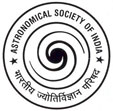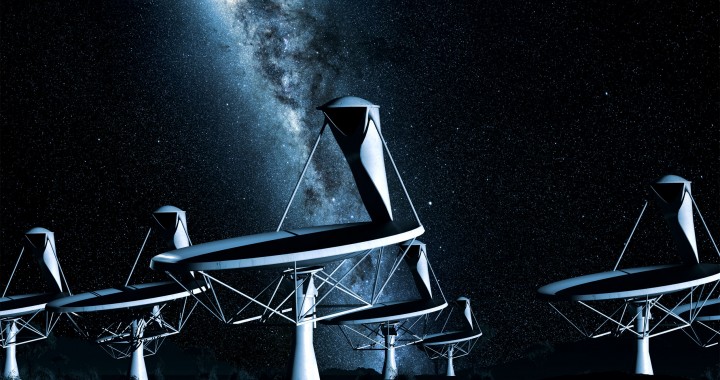
Artists impression of the SKA
India has formally initiated work towards the design of the Square Kilometre Array (SKA), which will be the world’s largest and most sensitive radio telescope. This telescope is an international project, and will be co-located in radio quiet regions of South Africa and Australia. The SKA Project is now entering an era where the teams responsible for design of the various parts of the telescope have been identified, and they are all set to start the work. . In total, more than three hundred and fifty scientists and engineers, representing 18 nations and drawn from nearly one hundred institutions, universities and industry have the challenging task to work on the critical detailed design phase which will usher in the most sensitive and powerful telescope ever devised. This design phase will last for 3 years, and lead directly to construction of phase I of the SKA, starting in 2017.
The Telescope Manager (TM) for SKA will be designed by an international consortium, led by the National Centre for Radio Astrophysics (NCRA-TIFR) in Pune, India. Of the 10 different components of the SKA, the Telescope Manager is a crucial element, and will perform the task of sending control commands to various subsystems, ensure successful astronomical observations, cooordinate between the various SKA components and the users, continuously monitor the status of the telescopes as well as ensure safety. NCRA-TIFR will draw upon its experience in building, operating and maintaining
the Giant Metrewave Radio Telescope (GMRT, Khodad, Maharashtra), the worlds largest low-frequency radio telescope, in the work for the Telescope Manger. Ongoing upgrade activities at the GMRT will also be beneficial to this work.
NCRA has formed an international consortium under its leadership, for designing the Telescope Manager. This team includes the Tata Research Development and Design Centre, Pune, a research team with vast experience in monitor and control systems for larger international science projects.
“This is a level of engagement only seen in revolutionary projects!”, said Professor Phil Diamond, Director General of the SKA Organisation to mark the formal inauguration of the design phase of the project in the first week of November 2013. “That
we have been able to pull together a team of some of the world’s best experts, most prestigious institutions and major companies reflects the passion and ambition of the scientific and engineering communities to work on an inspirational world-class project of the scale of the SKA.”
The total area of the full SKA will be roughly one square kilometre – this is 50 times the sensitivity, and 10000 times the survey speed, of the best telescopes of today. The scale of the SKA represents a huge leap forward in both engineering and research & development towards building and delivering a radio telescope, and will deliver a correspondingly transformational increase in science capability when operational. Eleven countries, including India, are currently working together for designing the SKA.
Each consortium, including the Telescope Manager, has already provided the SKA Organisation with detailed management and verification plans, schedules, milestones and budgets for the various elements with which they have been tasked. The SKA Organisation, which is coordinating this global effort, will oversee the work done by the consortia and ensure that this meets critical design reviews along the way. Similar to a jigsaw puzzle, the consortia teams will be called upon to ensure that their various elements integrate and interface as seamlessly as possible.
The TM consortium has ten international partners from 8 countries (India, South Africa, Australia, United Kingdom, Canada, Germany, Italy and Portugal), all of whom will pool in their knowledge of designing and building such monitor and control systems for large telescopes in the past.
As the leader of the Telescope Manager consortium, NCRA is organising a kick-off meeting of the entire international consortium during the week of 11-15 November . This meeting is being held at the NCRA, with 30 attendees from all of the 8 member countries, including partners from industry. The goals of this meeting are to evolve a shared vision and understanding of how to design this crucial part of the SKA, define mutual relationships and allocate responsibilities. Dr. Tim Cornwell, Head of Computing from the SKA, will also be attending this meeting.
Immediately following this week-long meeting, the exciting phase of designing the Telescope Manager will start and the final design will be delivered to the international community in three years.
Members of the Telescope Manager consortium are :
-
National Centre for Radio Astrophysics, Tata Institute of Fundamental
Research, Pune, India -
Tata Research Development and Design Centre, Pune, India
-
SKA South Africa, South Africa
-
Commonwealth Scientific and Industrial Research Organisation, Australia
-
Science and Technology Facilities Council, United Kingdom
-
National Research Council of Canada, Canada
-
National Institute for Astrophysics, Italy
-
Institute for Telecommunications, Portugal
-
GTD, Germany
For
more information on the SKA Project, visit the website
http://www.skatelescope.org
(Telescope Manager
LOGO –
http://www.skatelescope.org/wp-content/uploads/2011/04/TMlogo.jpg)
Artists impression of
the SKA
-
http://www.jodrellbank.manchester.ac.uk/research/ska//Dishes_overview_web_large.jpg
-
http://www.jb.man.ac.uk/news/2010/skaposts/combined.jpg
Contact Information
(NCRA Phone number 020-2571 9000/9241)
Prof. Yashwant Gupta
(NCRA), Project Lead
Dr. Niruj Mohan
Ramanujam (NCRA)
Dr. Yogesh Wadadekar
(NCRA)

